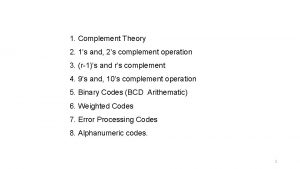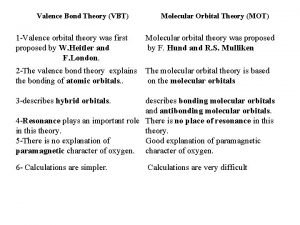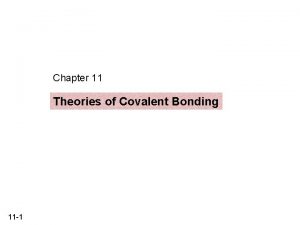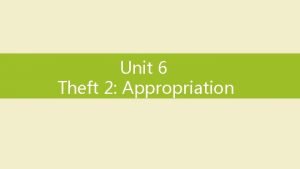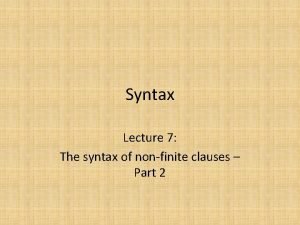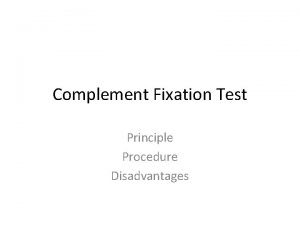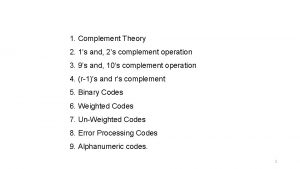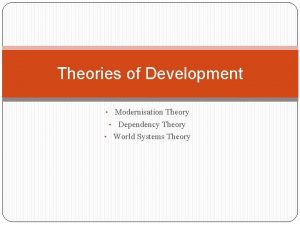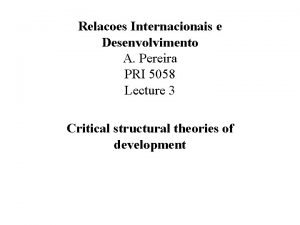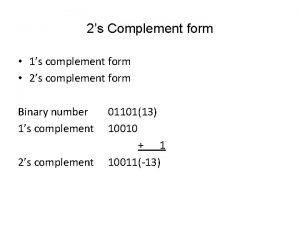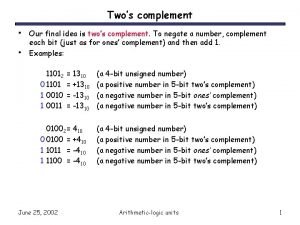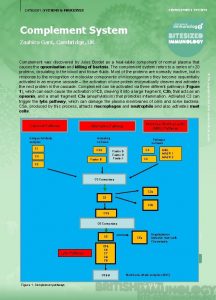1 Complement Theory 2 1s and 2s complement
































- Slides: 32

1. Complement Theory 2. 1’s and, 2’s complement operation 3. 9’s and, 10’s complement operation 4. (r-1)’s and r’s complement 5. Binary Codes 6. Weighted Codes 7. Un-Weighted Codes 8. Error Processing Codes 9. Alphanumeric codes. 1

1. Complement Theory Example 1 Get 1’s complement of 50 = 00000101 11111010 Complement Digits 2

1. 1’s Complement Theory Example 2 : Subtract 1010 from 1111 using 1’s complement theory. (Small negative) 1 0 1’s complement 1 1 + 0 1 0 1 1] 0 1 0 0 + 0 0 0 1 0 1 =(5) Carry “ 1” means the answer is positive. 3

1. 1’s Complement Theory Example 3 : Subtract 1010 from 1000 using 1’s complement theory. (Large negative) 1 0 1’s complement 1 0 0 0 + 0 1 0 1 0] 1 1 0 1 Carry “ 0” means the answer is negative and available in 1’s complement form. 1 1 0 0 1 0 = (2) 4

2’s Complement Arithmetic 1. How to get 2’s complement form 2. Arithmetic operation using 2’s complement theory 5

2’s Complement Arithmetic (How to get 2’s complement form. . ? ) Example 1 5 = 00000101 11111010 +1 -5 = 11111011 Complement Digits Add 1 Example 2 -13 = 11110011 00001100 +1 13 = 00001101 Complement Digits Add 1 6

2’s Complement Arithmetic (Method) 1. Read both the operands 2. Negative operand(s) (if any) is converted into 2’s complement form 3. Add both the numbers 4. If carry is generated (i. e. =1) then the resultant number is positive and in original form 5. If carry is not generated(when we have negative operand) then the carry is assumed =0. 6. If carry is not generated (with both the operand positive) then the answer is Positive. 7. Carry zero means the resultant number is negative and in a 2’s complement form. 8. Convert the 2’s complement form into the original form. 7

POS + NEG → POS Answer Take the 2’s complement of the negative number and use regular binary addition. 9 + (-5) 4 00001001 + 11111011 100000100 Last Bit = 1: Answer is Positive Disregard 9 th Bit 00000101 11111010 +1 11111011 2’s Complement Process 8

POS + NEG → NEG Answer Take the 2’s complement of the negative number and use regular binary addition. (-9) + 5 -4 11110111 + 00000101 011111100 Last Bit = 0: Answer is Negative. Discard the last bit To Check: Perform 2’s Complement On Answer 11111100 00000011 +1 00000100 00001001 11110110 +1 11110111 2’s Complement Process 9

Verify the logic using following combinations: 1: (10) –(01) 2: (10) –(02) 3: (10) –(05) 4: (10) –(08) 5: (10) –(09) 6: (10) –(10) 7: (210) –(08) 8: (120) –(55) 9: (52) –(18)

2’s Complement Arithmetic (Examples) A+B B 2’s of B Addition A=10 B=-1 0001 1110 0001 1111 1010 1111 11001 B=-2 0010 1101 0001 1110 1010 11000 B=-5 0101 1010 0001 1010 1011 10101 0111 0001 1000 1010 10010 B=-8 A 1010 1000 Ans CY =1 So ans is +ve +9 +8 +5 CY =1 So ans is +ve +2 CY =1 So ans is +ve B=-9 1001 0110 0001 0111 1010 0111 1 0 0 0 1 CY =1 So ans is +ve +1 B=-10 1010 0101 0001 0110 1010 0110 1 0 0 CY =1 So ans is +ve +0 11

2’s Complement Arithmetic (Examples) Example: Perform 2’s complement arithmetic for (30)-(50) using 1: 6 -bit number system 2: 8 -bit number system 12

Example: Perform 2’s complement arithmetic for (30)-(50) using: 1: 6 -bit number system 2: 8 -bit number system (30)= 0 1 1 0 (-50)= 1 1 0 0 1 0 Add both the numbers 2’s complement 0 0 1 1 000001 001110 011110 001110 0101100 Carry =0 means number is negative and in 2’s compl form 010011 000001 0 1 0 0 = -20 (30)= 0 0 0 1 1 0 (-50)= 0 0 1 1 0 0 1 0 2’s complement 1 1 0 0 1 1 00000001 11001110 Add both the numbers 00011110 110011101100 Carry =0 means number is negative and in 2’s compl form 00010011 00000001 0 0 0 1 0 0 = -20

(r-1)’s and r’s complement Example of r=9 9’ and 10’s complement

How to get (r-1)’s complement of decimal number…? Say r =10 How do we get (r-1)’s complement …? (r-1)′s i. e. 9’s complement of decimal number can be obtained by ((10 n - 1)-number) where n represents the number of digits in given number. Example 1: Find 9’s complement of (1234)10 9′s complement = 104 -1 -1234 = 9999 -1234 = 8765 How do we get (r)’s complement …? r's i. e. 10’s complement can be obtained by (10 n – number) where n represents the number of digits in given number. Example 2: Find 10′s complement = 104 -1234 = 8766. Now that we have learned to convert decimal number to its 9′s & 10′s complement, we will move to subtraction using them. Remember always the number to be subtracted or negative number is converted to 9′s or 10′s complement.

9’s Complement Arithmetic Example 1: Get 9’s complement of following numbers 99 -19 999 -146 9999 -4397 80 853 5602 (19)10 , (146)10, (4397)10 16

9’s Complement Arithmetic Example 1: Perform subtraction using 9’s complement on the data set given below. a: 18 -06, b: 39 -23 c: 34 -49 d: 49 -84 06 is negative number, We will get 9’s complement of 06 9 9 - 0 6 9 3 We will ADD 93 and 18 9 3 + 1 8 A carry is generated means answer is +ve ADD the carry back to the sum “ 11”. 1 1 + 1 1 1 1 2 17

9’s Complement Arithmetic Example 2: Perform 9’s complement subtraction on the data set given below. a: 18 -06, b: 39 -23 c: 34 -49 d: 49 -84 23 is negative number, We will get 9’s complement of 23 9 9 - 2 3 7 6 We will ADD 76 and 39 7 6 + 3 9 A carry is generated. ADD the carry back to the sum “ 15”. 1 5 + 1 1 1 5 1 6 18

9’s Complement Arithmetic Example 3: Perform 9’s complement subtraction on the data set given below. a: 18 -06, b: 39 -23 c: 34 -49 d: 49 -84 49 is negative number, We will get 9’s complement of 49 9 9 - 4 9 5 0 We will ADD 50 and 34 5 0 + 3 4 0 8 4 A carry is not generated that means answer is Negative. Get 9’s complement of 84 9 9 _ 8 4 1 5 Answer is -15 19

9’s Complement Arithmetic Example 4: Perform 9’s complement subtraction on the data set given below. a: 18 -06, b: 39 -23 c: 34 -49 d: 49 -84 84 is negative number, We will get 9’s complement of 84 9 9 - 8 4 1 5 We will ADD 15 and 49 4 9 + 1 5 0 6 4 A carry is not generated that means answer is Negative. Get 9’s complement of 64 9 9 _ 6 4 3 5 Answer is -35 20

10’s Complement Arithmetic Example 1: Perform 10’s complement subtraction on the data set given below. a: 24 -09, b: 69 -32 c: 265 -347 09 is negative number, We will get 10’s complement of 09 9 9 - 0 9 We will ADD 91 and 24 2 4 + 9 1 1 1 5 9 0 + 0 1 9 1 A carry is generated that means answer is Positive. Answer is +15 21

10’s Complement Arithmetic Example 2: Perform 10’s complement subtraction on the data set given below. a: 24 -09, b: 69 -32 c: 265 -347 32 is negative number, We will get 10’s complement of 32 9 9 - 3 2 We will ADD 68 and 69 6 8 + 6 9 1 3 7 6 7 + 0 1 6 8 A carry is generated that means answer is Positive. Answer is +37 22

10’s Complement Arithmetic Example 3: Perform 10’s complement subtraction on the data set given below. a: 24 -09, b: 69 -32 c: 265 -347 347 is negative number, We will get 10’s complement of 347 9 9 9 - 3 4 7 We will ADD 653 and 265 653 + 265 A carry is not generated that means answer is Negative and in 10’s complement form. 0 918 Get 10’s complement form of 918 6 5 2 + 0 1 9 9 9 -9 1 8 6 5 3 0 8 1 +0 0 1 0 8 2 Ans = -82 23

Binary Codes 1. Weighted Codes (8421, 5421) 2. Non Weighted codes (Excess-3 , BCD, Gray) 3. Error Processing Codes (PARITY Bits, Hamming Codes) 4. Alphanumeric Codes (ASCII, EBCDIC)

1: Weighted Codes: Weighted binary codes are those binary codes which obey the positional weight principle. Each position of the number represents a specific weight. 5421 8421 0000 0 0 1000 5 1 0100 4 4 0010 2 2 0001 1 1 0111 7 7 1111 12 15

2: Non-Weighted Codes: Non-weighted coding method that alters just one bit in a binary number when moving from one decimal number to the next. 2. 1: Excess-3 is a non-weighted coding method. With excess-3, we add 3 to a decimal number before converting it to binary. Example: (0001)2 = (0100)Excess-3 (0010)2 = (0101)Excess-3 2. 2: BCD (Binary Coded Decimals) is a non-weighted coding method. Individual decimal digits are converted into equivalent binary bits. Example: (321)2 = (0011 0010 0000)BCD (000)2 = (0000)BCD (80)2 = (1000 0000)BCD (00)2 = (0000)BCD

2: Non-Weighted Codes: Non-weighted coding method that alters just one bit in a binary number when moving from one decimal number to the next. 2. 3: Gray Codes: It is also called as Reflected Binary codes. It is generated via getting mirror image of given data. 0 0 Example : 4 bit Gray codes. 0 0 0 1 1 0 0 1 1 1 0 1 0 0 1 1 1 1 1 0 0 1 1 0

2: Non-Weighted Codes: Comparing Gray codes and Binary Codes Find out the difference between both the codes. . ?

2: Non-Weighted Codes: Converting Binary Codes to Gray codes Method: 1. 2. 3. 4. Copy MSB of Binary code to MSB of Gray code. Add MSB of Binary with Next MSB of Binary to get next Gray code. Discard the carry Repeat the same process till we get the LSB Example: Convert (0001)2 into Gray code. 0 0+0= 0 0 0 0 1 0+1= 1 1

2: Non-Weighted Codes: Converting Binary Codes to Gray codes Method: 1. 2. 3. 4. Copy MSB of Binary code to MSB of Gray code. Add MSB of Binary with Next MSB of Binary to get next Gray code. Discard the carry Repeat the same process till we get the LSB Example: Convert (1011)2 into Gray code. 1 0 1 1+0= 1 0+1= 1 1 1+1= 0 0

2: Non-Weighted Codes: Converting Gray Codes to Binary codes Method: 1. Copy MSB of Gray code to MSB of Binary code. 2. If next bit of Gray code is “ 1”, then invert the present binary bit as next bit. 3. If next bit of Gray code is “ 0” then copy the present binary bit as next bit. Example: Convert (1011) gray into Binary code. 1 0 1 1

 Subtraction using 1's complement
Subtraction using 1's complement Venn diagram notation
Venn diagram notation Trait approaches to leadership
Trait approaches to leadership Continental drift vs plate tectonics theory
Continental drift vs plate tectonics theory Plate tectonic theory vs continental drift
Plate tectonic theory vs continental drift Neo classical organizational theory
Neo classical organizational theory Theory x and theory y of motivation
Theory x and theory y of motivation Semantic satiation
Semantic satiation Rate theory of chromatography
Rate theory of chromatography Lien theory vs title theory
Lien theory vs title theory Theory x definition
Theory x definition Game theory and graph theory
Game theory and graph theory Mot vs vbt
Mot vs vbt Valence bond theory vs molecular orbital
Valence bond theory vs molecular orbital Theory x and theory y
Theory x and theory y Valence bond theory and molecular orbital theory
Valence bond theory and molecular orbital theory Theories of covalent bonding
Theories of covalent bonding Bond order of li2
Bond order of li2 Difference between theory x and theory y
Difference between theory x and theory y Difference between object and complement
Difference between object and complement Difference between object and complement
Difference between object and complement To wait seemed foolish when decisive action was required
To wait seemed foolish when decisive action was required A verb form that functions as a noun is called a(n) .
A verb form that functions as a noun is called a(n) . Indirect compliments examples
Indirect compliments examples Advantages and disadvantages of 2's complement
Advantages and disadvantages of 2's complement Example for sva pattern
Example for sva pattern How to find 9 complement of a decimal number
How to find 9 complement of a decimal number Object and complement
Object and complement X bar theory
X bar theory Complement fixation test: principle
Complement fixation test: principle Modernization theory vs dependency theory
Modernization theory vs dependency theory Colour design: theories and applications
Colour design: theories and applications Importance of dependency theory
Importance of dependency theory
